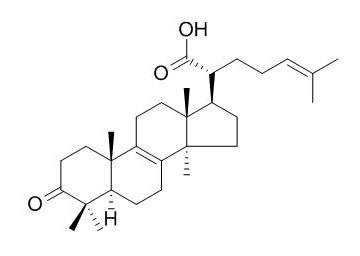Beta-Elemonic acid
Beta-Elemonic acid exhibits anti-inflammatory, and anti-cancer effects, it inhibits proliferation by inducing hypoploid cells and cell apoptosis, the anticancer effects of beta-Elemonic acid are related to the MAPK signaling pathway, ROS activation and glutathione depletion in human A549 lung cancer cells. Beta-Elemonic acid exhibits prolyl endopeptidase inhibitory activities.
Inquire / Order:
manager@chemfaces.com
Technical Inquiries:
service@chemfaces.com
Tel:
+86-27-84237783
Fax:
+86-27-84254680
Address:
1 Building, No. 83, CheCheng Rd., Wuhan Economic and Technological Development Zone, Wuhan, Hubei 430056, PRC
Providing storage is as stated on the product vial and the vial is kept tightly sealed, the product can be stored for up to
24 months(2-8C).
Wherever possible, you should prepare and use solutions on the same day. However, if you need to make up stock solutions in advance, we recommend that you store the solution as aliquots in tightly sealed vials at -20C. Generally, these will be useable for up to two weeks. Before use, and prior to opening the vial we recommend that you allow your product to equilibrate to room temperature for at least 1 hour.
Need more advice on solubility, usage and handling? Please email to: service@chemfaces.com
The packaging of the product may have turned upside down during transportation, resulting in the natural compounds adhering to the neck or cap of the vial. take the vial out of its packaging and gently shake to let the compounds fall to the bottom of the vial. for liquid products, centrifuge at 200-500 RPM to gather the liquid at the bottom of the vial. try to avoid loss or contamination during handling.
Spectrochim Acta A2019, 210:372-380
BMC Complement Altern Med.2019, 19(1):339
Aging (Albany NY).2021, 13(19):22867-22882.
Foods2023, 12(23), 4342.
Oxid Med Cell Longev.2021, 2021:4883398.
Comput Biol Med.2024, 178:108775.
Chem Biol Interact.2019, 298:1-7
J Ethnopharmacol.2017, 206:73-77
Food Res Int.2018, 106:909-919
Food Addit Contam Part A.2021, 38(12):1985-1994.
Related and Featured Products
Oncol Rep. 2016 Jan;35(1):227-34.
β-Elemonic acid inhibits the cell proliferation of human lung adenocarcinoma A549 cells: The role of MAPK, ROS activation and glutathione depletion.[Pubmed:
26530631 ]
Beta-Elemonic acid, a known triterpene, exhibits anti-inflammatory effects, yet research on the pharmacological effects of Beta-Elemonic acid is rare.
METHODS AND RESULTS:
We investigated the anticancer effects and the related molecular mechanisms of Beta-Elemonic acid on human non-small cell lung cancer (NSCLC) A549 cells. The effects of Beta-Elemonic acid on the growth of A549 cells were studied using a 3-(4,5)-2,5-diphenyltetrazolium bromide (MTT) assay. Apoptosis was detected using Annexin V staining. The effect of Beta-Elemonic acid on the cell cycle of A549 cells was assessed using the propidium iodide method. The change in reactive oxygen species (ROS) was detected using a dichlorodihydrofluorescein diacetate (DCFH-DA) assay with microscopic examination. The expression levels of Bcl-2 family proteins, mitogen-activated protein kinase (MAPK) family proteins and cyclooxygenase 2 (COX-2) were detected using western blot analysis. Our data revealed that β-elemonic acid strongly induced human A549 lung cancer cell death in a dose- and time-dependent manner as determined by the MTT assay. Beta-Elemonic acid-induced cell death was considered to be apoptotic when the phosphatidylserine exposure was observed using Annexin V staining. The death of human A549 lung cancer cells was caused by apoptosis induced by activation of ROS activity, increase in the sub-G1 proportion, downregulation of Bcl-2 expression, upregulation of Bax expression and inhibition of the MAPK signaling pathways.
CONCLUSIONS:
These results clearly demonstrated that Beta-Elemonic acid inhibits proliferation by inducing hypoploid cells and cell apoptosis. Moreover, the anticancer effects of Beta-Elemonic acid were related to the MAPK signaling pathway, ROS activation and glutathione depletion in human A549 lung cancer cells.
J Nat Prod. 2005 Feb;68(2):189-93.
Bioactive constituents from Boswellia papyrifera.[Pubmed:
15730241 ]
METHODS AND RESULTS:
Phytochemical investigation of the stem bark extract of Boswellia papyrifera afforded two new stilbene glycosides, trans-4',5-dihydroxy-3-methoxystilbene-5-O-{alpha-L-rhamnopyranosyl-(1-->2)-[alpha-L-rhamnopyranosyl-(1-->6)]-beta-D-glucopyranoside (1), trans-4',5-dihydroxy-3-methoxystilbene-5-O-[alpha-L-rhamnopyranosyl-(1-->6)]-beta-D-glucopyranoside (2), and a new triterpene, 3alpha-acetoxy-27-hydroxylup-20(29)-en-24-oic acid (3), along with five known compounds, 11-keto-beta-boswellic acid (4), Beta-Elemonic acid (7), 3alpha-acetoxy-11-keto-beta-boswellic acid (8), beta-boswellic acid (9), and beta-sitosterol (10).
CONCLUSIONS:
The stilbene glycosides exhibited significant inhibition of phosphodiesterase I and xanthine oxidase. The triterpenes (3-9) exhibited prolyl endopeptidase inhibitory activities.



